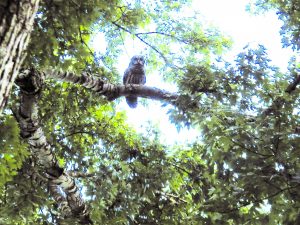There’s something particularly special about owls! Owls have this majestic soul, a sort of old and wise air with a special aura. What is it about their eyes that simply captivate you?
A few weeks ago about 8 pm, my daughter called my phone. She was in our front yard and excitedly yelled, “Momma, grab your camera and get out here. There’s owls in your front trees!” I went flying out, expecting them to be long gone, but there they were, two Barred Owls! One was way up in the tree top, and the other was a little harder to find, as it was leaning up against the tree trunk, turned sideways in a bend of two limbs.
The next night I went out in the light rain around the same time, right before dusk, and there they flew in again. I knew to look for them when the song birds started yelling a warning. Since I now knew we had two new friends in our yard, I thought I’d do a little research. I found out that Barred owls are known to mate for life, breed once yearly between December and March, and, on the average, have two eggs per season, and can have up to five. After about 30 days, the eggs hatch, and the hatchlings are ready for flight in about 6 weeks.
Barred Owls tend to live in older forests and they require dense foliage for daytime roosting, and large trees with cavities for nesting, and often found around water sources. This species is also known to use empty hawk nests, crow nests, or squirrel nests. Barred Owls don’t migrate, and most will remain in a single area their whole lives, though on rare occasions they may wander farther in search of food during winters when prey is scarce. In one study of 158 birds that were banded and then found later, none had moved farther than 6 miles away. Existing studies have found young owls, however, may venture further away from their natal nests – as close as half a mile and as far as 1,000 miles away. Life span for these Barred owls has been known to exceed 10 years in the wild, while captives have been known to live up to 23 years.
Small mammals and rabbits make up most of their diet, but they also eat birds as big as grouse, and amphibians, reptiles, and invertebrates. They hunt by sitting and waiting on an elevated perch, while scanning all around for prey with their sharp eyes and ears. They may perch over water and drop down to catch fish, or even wade in shallow water in pursuit of fish and crayfish. Though they do most of their hunting right after sunset and during the night, sometimes they feed during the day. They are a very vocal species, with an easily recognizable 9 syllable call; “Who cooks for you? Who cooks for you-all?”, called a two-phrase hoot. I am becoming very attached to these two owls, and hope they decide to call our yard their permanent home!



